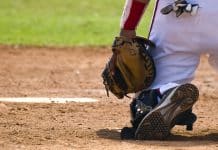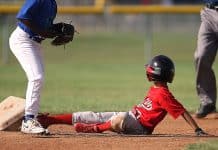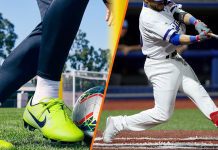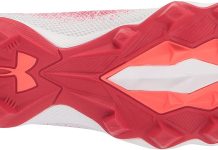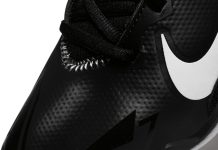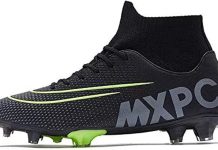So, you’ve been wondering about the differences between baseball, soccer, and football cleats?
Well, you’ve come to the right place! In this article, we will explore the unique features and characteristics that set baseball cleats apart from their soccer and football counterparts.
Whether you’re an avid player or simply curious about the world of sports footwear, we have all the information you need to understand the critical distinctions between these three cleats.
So, let’s lace up and get ready to uncover the secrets behind baseball cleats!
Style of Play
Review contents
Baseball
Baseball is a sport that involves running, sliding, and quick changes in direction. As a player, you need cleats that provide stability and traction on the field.
Baseball cleats are designed to grip the dirt and grass surfaces of the baseball diamond, allowing you to make sharp turns and quick stops without slipping. The style of play in baseball requires cleats that can handle the demands of the game, such as constant running and sudden bursts of speed.
Soccer
Soccer, on the other hand, is a game that demands agility, speed, and precise footwork. Soccer cleats are designed to enhance a player’s ability to move quickly on the field. The style of play in soccer involves a lot of running, cutting, and changing directions, so soccer cleats focus on providing excellent traction on both natural grass and artificial turf surfaces. The cleat design in soccer also emphasizes flexibility and lightweight materials to facilitate quick movements and precise ball control.
Football
Football is a high-impact sport that requires players to have excellent agility, strength, and speed. Football’s style involves many explosive movements, such as sprinting and cutting, as well as tackling and blocking. Football cleats are designed to provide stability and support to the player, especially around the ankle area, to prevent injuries. The cleat design in football focuses on traction and grip on various playing surfaces, including grass and synthetic turf.
Outsole
Baseball
The outsole of baseball cleats is designed to provide maximum traction and grip on dirt and grass surfaces. It usually features molded rubber or metal studs that dig into the ground, allowing players to maintain stability and control while running, sliding, and making quick turns. The outsole studs of baseball cleats are evenly distributed to ensure traction in all directions, as the game requires players to move in various directions at different speeds.
Soccer
Soccer cleats have specialized outsoles engineered to provide high levels of grip on natural grass and artificial turf. The outsole design in soccer cleats usually incorporates molded or removable studs or blades. These studs or blades are strategically positioned to offer optimal traction, allowing players to change direction quickly and maintain balance on the slippery surfaces often encountered in soccer. The outsole of soccer cleats is usually lighter and more flexible than other sports cleats.
Football
Football cleats have a unique outsole design that focuses on providing stability and support during the intense physical movements of the game. They typically feature molded or detachable studs that offer superior traction on grass and synthetic turf.
The outsole studs in football cleats are often longer, and more spread out for better grip and control, especially during lateral movements and quick changes in direction.
The outsole of football cleats is designed to withstand the impact of high-velocity movements, ensuring that players can maintain their footing and avoid injuries.
Cleat Design
Baseball
The design of baseball cleats is characterized by a low-cut profile, allowing for better mobility and flexibility. This design enables players to have a wide range of motion, essential in baseball for running, sliding, and making quick stops.
Baseball cleats often have a lace or strap closure system to provide a secure fit. The materials used in the upper part of baseball cleats are typically synthetic leather or mesh for durability and breathability.
Soccer
Soccer cleat design emphasizes versatility and ball control. Depending on the player’s preference and position, they are typically designed with a low, mid, or high-cut profile. The low-cut design offers agility and freedom of movement, ideal for midfielders and forwards. Mid-cut cleats provide additional ankle support, preferred by defenders and players with a history of ankle injuries.
High-cut cleats offer the highest level of ankle support and are commonly worn by goalkeepers. Soccer cleats are made with lightweight materials, such as synthetic leather or mesh, to enhance speed and maneuverability while allowing for precise ball touches and control.
Football
The design of football cleats focuses on providing support, stability, and protection, particularly around the ankle area. They are usually high-cut or mid-cut, offering more coverage and support for the ankle compared to baseball and soccer cleats.
Football cleats often have a secure closure system, such as laces, Velcro straps, or a combination, to ensure a snug fit and prevent slippage during intense movements. They also feature a more durable upper material, such as synthetic leather or a combination of synthetic and mesh, to withstand the game’s physical demands.
Cleat Material
Baseball
Baseball cleats are commonly made from synthetic leather or mesh upper materials. Synthetic leather provides durability and resistance to wear and tear, ensuring that the cleats can withstand the rigors of the game.
Mesh materials are often incorporated into the design to enhance breathability, keeping the player’s feet cool and reducing sweat accumulation. These materials are chosen to strike a balance between durability, flexibility, and breathability, ensuring that baseball cleats can endure the demands of the sport while maintaining comfort.
Soccer
Soccer cleats are predominantly made from lightweight synthetic materials. These materials are chosen to combine durability, flexibility, and breathability. Synthetic leather is commonly used in the upper construction of soccer cleats due to its lightweight properties and ability to mimic the feel of natural leather.
Using synthetic materials also allows for better ball control and a more precise touch. The mesh panels incorporated into soccer cleats enhance airflow, keeping the player’s feet dry and reducing the risk of discomfort or blisters during prolonged play.
Football
Football cleats are designed to withstand the physicality of the game. As a result, they are typically made from high-quality, durable synthetic materials. Synthetic leather, or a combination of synthetic and genuine leather, is often used in the upper construction to enhance durability, protection, and resistance to wear and tear.
The materials used in football cleats ensure they can endure the forceful impact and constant contact experienced during gameplay. This durability is paramount, considering football’s high demands and rough nature.
Stud Configuration
Baseball
The stud configuration of baseball cleats is designed to maximize traction and grip on dirt and grass surfaces. Baseball cleats often have either molded rubber or metal studs. Molded rubber studs are fixed to the outsole and are evenly distributed throughout, providing reliable grip and stability in all directions.
On the other hand, metal studs can be detachable or permanent and offer enhanced traction, especially in wet or muddy conditions. The stud configuration in baseball cleats allows players to maintain their footing and perform quick movements without slipping.
Soccer
Soccer cleat stud configurations vary depending on the playing surface. Soccer cleats usually feature traditional conical studs or bladed studs for natural grass surfaces. These studs penetrate the ground, providing excellent stability and traction while allowing players to pivot and change directions quickly.
For artificial turf surfaces, soccer cleats are often designed with more minor, dimpled studs or an almost entirely flat outsole for maximum grip without causing damage to the turf. The stud configurations in soccer cleats are carefully chosen to optimize performance and prevent injuries.
Football
Football cleat stud configurations are tailored to provide traction and grip on various playing surfaces. They commonly feature a combination of molded and detachable studs.
The molded studs are strategically placed around the outsole’s perimeter for stability and support. In contrast, the detachable studs are positioned in the center for added traction on softer or wetter surfaces. The stud configurations in football cleats are engineered to ensure players can make explosive movements, maintain their balance, and quickly change direction on various playing surfaces.
Ankle Support
Baseball
Baseball cleats typically have a low-cut design, providing minimal ankle support. In baseball, ankle support is not a primary concern as the style of play does not involve significant contact or sudden changes in direction that put excessive strain on the ankle.
The low-cut design allows an unrestricted range of motion and facilitates quick movements and agility on the field. While ankle injuries can still occur in baseball, players often rely on other protective gear, such as ankle braces or tape, to provide additional support and reduce the risk of injury.
Soccer
Soccer cleats offer varying levels of ankle support depending on the cut and design. Low-cut cleats provide little to no ankle support, allowing maximum movement freedom. Mid-cut cleats offer moderate ankle support, benefiting players who want a balance between mobility and some degree of ankle stability.
High-cut cleats provide the highest level of ankle support, as the extended collar wraps around the ankle, providing additional protection against sprains and twists. The choice of ankle support in soccer cleats depends on the player’s preference, position, and susceptibility to ankle injuries.
Football
Football cleats prioritize ankle support due to the physical nature of the sport. Football players often experience high-velocity movements, collisions, and tackles that require stability and protection for the ankles.
Football cleats are typically designed with a mid-cut or high-cut collar that extends above the ankle, offering excellent support and preventing excessive rolling or twisting. This added ankle support helps reduce the risk of sprains and other ankle injuries that frequently occur in football.
Weight
Baseball
Weight is not a significant consideration when it comes to baseball cleats. Baseball focuses more on performance and traction rather than minimizing weight. Baseball cleats tend to be slightly heavier than soccer and football, as they prioritize stability and grip over lightweight design. While baseball cleats need to be comfortable and not overly heavy, the emphasis on weight is not as crucial as in other sports where speed and agility are paramount.
Soccer
Soccer cleats are designed with a strong emphasis on lightweight construction. The lighter the cleats, the faster and more agile a player can be on the field. Soccer players constantly need to sprint, change direction, and react quickly, so reducing weight is a significant factor in cleat design. Lightweight materials, such as synthetic leather and mesh, minimize the overall weight of soccer cleats. This focus on weight allows soccer players to move effortlessly and maximize their speed and agility during the game.
Football
Football cleat design takes into account the need for both stability and speed. While weight is a consideration, it is not the primary factor in football cleats. The emphasis in football is on providing support, protection, and traction, given the physicality of the sport. Football cleats are designed to withstand the forces exerted during gameplay and typically have a slightly heavier construction than soccer cleats. However, recent advancements in materials and technology have allowed manufacturers to reduce the weight of football cleats while maintaining the necessary stability and performance.
Playing Surface
Baseball
Baseball cleats are specifically designed for playing on dirt and grass surfaces. The deep studs or spikes on baseball cleats penetrate the ground, providing excellent traction on these playing surfaces. The dirt and grass fields in baseball can become slippery, especially in wet or muddy conditions, so baseball cleats are engineered to dig into the ground and minimize slippage. Baseball cleats’ stud configuration and outsole are optimized for these specific playing surfaces, enhancing performance and ensuring stability.
Soccer
Soccer cleats are designed to accommodate different playing surfaces, including natural grass, artificial turf, or indoor courts. The stud configurations and outsole patterns vary depending on the type of surface. For natural grass, soccer cleats have longer, more aggressive studs or blades to penetrate the soil and provide stability. For artificial turf, shorter, dimpled studs or a flat outsole are typical to prevent damage to the turf while maintaining grip. Indoor soccer cleats have a non-marking rubber outsole that provides grip without leaving marks on the court. Soccer cleats are adaptable to different surfaces, allowing players to perform at their best regardless of the playing conditions.
Football
Football cleats are designed to handle a range of playing surfaces, including natural grass, artificial turf, and sometimes indoor courts. The stud configurations in football cleats are engineered to provide traction and stability on different surfaces. Football cleats have longer studs for natural grass that can penetrate the soil and offer grip. For artificial turf, shorter studs or a combination of molded and detachable studs prevent excessive traction and minimize stress on the knees and ankles. Indoor football cleats have a non-marking rubber outsole that provides traction on indoor courts without leaving marks. Football cleats adapt to various playing surfaces to ensure players can perform at their best and maintain stability.
Durability
Baseball
Baseball cleats are designed with durability in mind. The materials used in baseball cleats, such as synthetic leather and mesh, are chosen for their ability to withstand the demands of the game. Baseball cleats need to withstand constant running, sliding, sharp movements, and exposure to dirt and moisture.
Reinforced stitching, durable upper materials, and robust outsoles make baseball cleats resistant to wear and tear. While individual playing styles and field conditions can affect the lifespan of baseball cleats, overall, they are built to be durable and withstand the rigors of the diamond.
Soccer
Soccer cleats are designed to be durable while maintaining their lightweight properties. The materials used, such as synthetic leather and mesh, are chosen for their ability to withstand the demands of the game.
Soccer players often encounter abrasive surfaces, ball impacts, and the wear and tear associated with rapid changes in direction and sliding tackles. Soccer cleats are strengthened with reinforced stitching, protective overlays, and solid outsoles to extend their lifespan. With proper maintenance and care, soccer cleats can endure multiple seasons and maintain their performance.
Football
Football cleats are designed to be highly durable due to the physicality and intense movements involved in the sport. The materials used in football cleats, such as synthetic leather and reinforced synthetic materials, are chosen for their ability to withstand impact, constant running, and aggressive actions on the field.
Football cleats have robust construction, including reinforced toe boxes, solid midsoles, and sturdy outsoles, to ensure they can endure the physical contact and constant pounding experienced in football. While the lifespan of football cleats can vary based on individual usage and playing conditions, they are built to be durable and able to withstand the rigors of the game.
Price
Baseball
The price range for baseball cleats can vary depending on brand, materials used, and additional features. Entry-level baseball cleats can cost anywhere from $30 to $70. These cleats typically offer basic functionality and durability.
Midrange baseball cleats, priced between $70 and $120, may offer enhanced comfort, additional features, or branding from well-known sports equipment manufacturers. High-end baseball cleats, often priced above $120, are designed with advanced technologies, premium materials, and superior performance characteristics. The price of baseball cleats ultimately depends on the level of play, player preferences, and budget considerations.
Soccer
Soccer cleats are available in a wide price range to cater to different budgets and player needs. Entry-level soccer cleats can be found between $30 and $70. These cleats usually offer basic functionality and durability, suitable for recreational or beginner players.
Midrange soccer cleats, priced between $70 and $120, may offer improved performance characteristics, additional technologies, or branding from reputable sports equipment manufacturers. High-end soccer cleats, priced above $120, are designed with the latest technologies, premium materials, and advanced performance features. The price of soccer cleats varies based on brand, construction, and the level of play.
Football
Football cleats are available at different prices to accommodate various budgets and player preferences. Entry-level football cleats typically cost between $30 and $70 and offer basic functionality and durability. These cleats are suitable for recreational or beginner players.
Midrange football cleats, priced between $70 and $120, may offer improved performance features, added technologies, or brand affiliation from established sports equipment manufacturers. High-end football cleats, priced above $120, are designed with cutting-edge technologies, premium materials, and advanced performance characteristics. The price of football cleats depends on factors such as brand reputation, construction, and the level of play.








